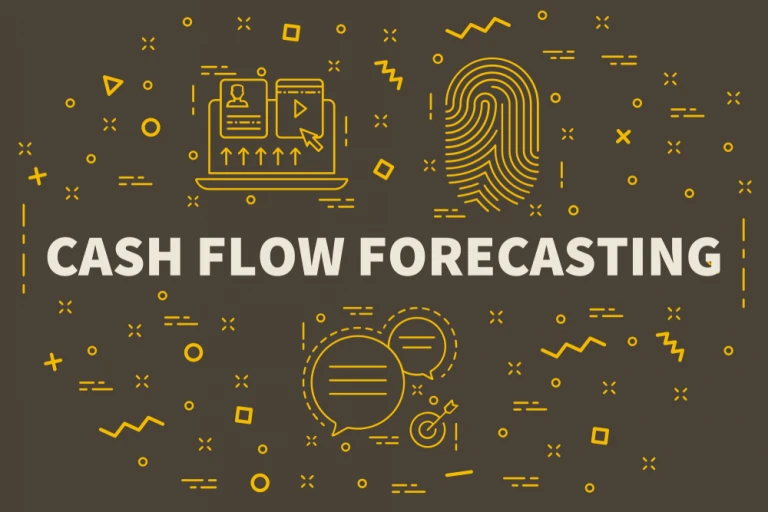How to create a cash flow forecast
HOME / / How to create a cash flow forecast

What is cash flow forecasting?
Cash flow forecasting means predicting how much money you have available in your business to be able to keep trading.
You estimate all of the money you’ll make during the forecast period and all of the costs you’ll incur. Matching these up – month by month – helps you understand when you might run low on cash.
Cash flow problems can spell big problems for business. You might have plenty of money in theory but if this is tied up in outstanding invoices and inventory, you won’t have access to it to advance your business.
If you haven’t got the cash flowing through your business – to be able to buy new stock or deliver your services for example – you could be stuck.
How does cash flow forecasting help a business?
A cash flow forecast helps you understand how money moves through your business, so that you can amend your plans or arrange borrowing when the coffers are running low.
Knowing when you’ll have less money in the bank helps you to:
plan ahead – make more informed decisions because you have more information
budget appropriately – tighten your belt or decide to invest at the right time
identify when you might need extra financial help – apply for a business loan or other source of credit to see you thorough
The goal of cash flow forecasting is to make sure that you never have a day where you don’t have enough cash in your business to pay all of your bills. And so that, if you see that’s going to happen, you have enough notice to prevent it.
Added bonus, recording cash flow can help you spot tardy customers who don’t pay on time. These guys might need extra chasing…or avoiding altogether in future.

Why is cash flow forecasting important for new businesses?
When you start a business, you’re likely to incur startup costs before you start making sales and earning money.
You might need to invest in equipment, marketing, staff costs etc, just to start trading. This can mean cash flowing out of your business, before it has time to flow back in.
Many businesses fail in the first year because of cash flow problems, so taking the time to create a cash flow forecast can really help you keep on top of your finances and prepare for success.
How far ahead should a cash flow forecast be?
The most common forecast period is a year. This could be a:
calendar year
financial, tax or accounting year
For startups, it could make sense to start your forecast period from the date on which you actually start the business.
Depending on your business model you might also want shorter cash flow forecasts that cover a period of months or weeks, or longer-term forecasts.
It’s worth remembering that the further ahead you look, the less accurate your forecast is likely to be.
However, cash flow forecasting is only ever a guide. It does not need to be accurate to the last penny and can be revised as you go along, so a longer-term forecast can be helpful in some situations as long as they are regularly revised and kept up to date.
What is a quick way to forecast cash flow?
If you run a small business or one that doesn’t have a large number of incomings and outgoings, you can perform a quick and easy cash flow forecast.
To do this, you just need to compare the total of your unpaid purchases against the total sales due at the end of each month.
If the total unpaid purchases are more than the total sales due, you will be spending more than you receive that month. If that carries on, you potentially have a problem.
How to forecast cash flow
Step 1: Make your sales forecast
For an established business you can base this on previous year. For a startup, you will rely on your market research and business plan. Don’t forget to account for any changes like new product launches and contracts you expect to win.
You should predict and record sales without including sales taxes like VAT in the calculations.
An example of a sales forecast might look similar to the below:
Product Name | Jan-20 | Feb-20 | March-20 | April-20 |
Product / Service 1 | ||||
Price per unit (inc.VAT @20%) | £100 | £100 | £100 | £100 |
Units sold | 50 | 60 | 70 | 80 |
TOTAL | £5,000 | £6,000 | £7,000 | £8,000 |
Product / Service 2 | ||||
Price per unit (inc.VAT @20%) | £50 | £50 | £50 | £50 |
Units sold | 100 | 110 | 120 | 130 |
TOTAL | £5,000 | £5,500 | £6,000 | £6,500 |
TOTAL | £10,000 | £11,500 | £13,000 | £14,500 |
Step 2: Make a profit and loss forecast
By creating the expenses equivalent of the above table, you can now bring in all of your costs. These could include costs for materials or stock as well as day-to-day running costs, wages, rent, utilities and everything else that you have to pay out. For the profit and loss part of the forecast, record your costs in the month you incur them, which might not be the month you actually pay for them.
Step 3: Make your cash flow forecast
Use these first two forecasts to help prepare your cash flow forecast. Using a spreadsheet you can add all your predicted sales and set these against your total costs - leaving you with how much cash you can expect to be left with. Don’t forget to record your incoming and outgoing funds on the days/months they are actually received and paid, not when they are invoiced or incurred.

How can I improve my cash flow for my small business?
Invoice more effectively
If you’re a busy small business owner, you might be partly to blame for your cash flow woes. You’re so busy delivering your services that you forget to invoice on time and you don’t have the energy or enthusiasm for chasing late payments. Hiring a bookkeeper, accountant or using accounting software could be a good idea in these circumstances. We’ve negotiated discounts on some software we trust, so take a look at Xero in our marketplace.
Borrow, short-term
Borrowing some money allows you to keep up with your payment commitments and continue to grow your business, even if you’ve hit a short-term cash flow problem. Before borrowing, however, make sure that your financial issue is just a short-term cash flow problem and not a long-term chronic issue. Borrowing to bailout out a failing business isn’t a good idea. Responsible lenders won’t provide a loan in these circumstances and the alternative – irresponsible lenders – are something you definitely want to avoid. Read about what to expect when applying for a business loan.
Negotiate on payment terms
One way to improve your cash flow is to ask for payment faster and to take longer to pay what you owe. Talk to your clients about a shorter payment terms, and to your suppliers about longer ones.
Can I get a loan to help with cash flow?
All businesses face cash flow challenges and there is a range of business finance options to help. These include:
A small business loan
Another source of credit

"We’re delighted to be the 2000th loan recipients!"
